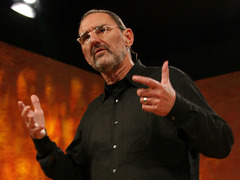[ted id=1598]
Air conditioning used to be a luxury — but as Doris Kim Sung points out in this talk from TEDxUSC, modernized society has become thoroughly air-conditioning reliant.
This is largely a problem of materials, says Sung, a professor at the USC School of Architecture. Many new buildings — especially skyscrapers — are built with floor-to-ceiling windows, which means that the spaces inside are constantly heated by the greenhouse effect and that the windows cannot be opened to let in a breeze. But could there be a smarter material that is better able to regulate inside temperature?
Sung — who studied biology before she became an architect — has given herself the challenge of creating a metal that acts like human skin, in which pores and sweat glands work together to provide cooling. She has created a thermo-bimetal that bends and flexes depending on outside temperature, without using any energy at all. Crafted into interlocking strips, these thermo-bimetals warp in the sun to form a canopy that shades an area, while leaving openings for ventilation. Having tested the strips in installations (check out her sculpture “Bloom”), Sung now imagines using them in the creation of new buildings, as well as in replacement windows that could be fitted into existing ones. Thermo-bimetals could potentially replace curtains and shutters, providing privacy while also lowering air-conditioner reliance.
“When you’re tired of opening and closing those blinds day after day, when you’re on vacation and there’s no one on the weekends to turn off the controls, or when there’s a power outage and there’s no electricity to rely on, these thermo-bimetals will still be working tirelessly, efficiently and endlessly,” says Sung.
To see exactly how these thermo-bimetals work and to hear about how Sung is also taking inspiration from eyelashes and grasshoppers for new materials, watch her talk. Below, a few other TED speakers who also have creative ideas for how to keep us cool.
 Wolfgang Kessling: How to air-condition outdoor spaces
Wolfgang Kessling: How to air-condition outdoor spaces
Wolfgang Kessling: How to air-condition outdoor spaces In June of 2022, Qatar will host the World Cup. Wolfgang Kessling has been tasked with creating an open-air stadium for the event that will keep both fans and players comfortable in the 106F/41C heat. In this talk from the TEDxSummit in Doha, Kessler explains that the plan isn’t to blast air conditioning, but to use innovative shading as well as chilled water piped through the stadium’s floor. (Read the TED Blog’s roundup of five public spaces with surprising cooling systems.) |
 Kamal Meattle: How to grow fresh air
Kamal Meattle: How to grow fresh air
Kamal Meattle: How to grow fresh air As activist Kamal Meattle shared at TED2009, it is possible to grow your own air indoors. He explains how three common household plants — Areca palm, Mother-in-law’s tongue and the Money plant — can be placed in specific spots in a home or office to dramatically improve the air quality. |
 Thom Mayne: How architecture can connect us
Thom Mayne: How architecture can connect us
Thom Mayne on architecture as connection Architecture is about the world of ideas bumping up with the limitations of reality, says architect Thom Mayne. At TED2005, he takes us on a tour of some of the buildings he’s created, including an office in San Francisco whose tower has no air conditioning at all. Instead, it uses a skin that moves on hydraulics, forcing air through it. |
Comments (31)